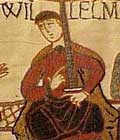 |
William I
b. c. 1027/1028, Falaise, Normandy
d. 9 Sep 1087, priory of Saint-Gervais, near Rouen, Normandy |
| Title: |
Rex Anglorum (King of the English) [1] |
| Term: |
25 Dec 1066 - 9 Sep 1087 |
| Chronology: |
25 Dec 1066, crowned, Westminster Abbey |
| |
9 Sep 1087, died |
| Names/titles: |
Comes (dux) Normannorum (Count [duke] of the Normans) [after July 1035] [2]; Count of Maine [from 1063]; byname: William the Conqueror, William the Bastard [French: Guillaume le Conquérant, Guillaume le Bâtard] |
| Biography: |
| The illegitimate son of Count Robert of Normandy, and his concubine Herleva (Arlette), William was nominated heir before his father went on a pilgrimage to Jerusalem. Robert died in Nicea in July 1035 and as soon as the news of his passing was known in Normandy, the young William was accepted as count by the Norman magnates. In the next twelve years three of William's guardians were murdered and Normandy entered the period of anarchy. It was not until 1047, when William assured his position by defeating the Norman rebels at Val-des-Dunes near Caen with the help of King Henri I of France. In 1051 William visited England and probably received from his childless cousin, Edward the Confessor, a promise of the English succession. According to Norman writers, Edward's brother-in-law, Harold Godwinesson (later King Harold), who accidentally visited the Norman court in 1064 or 1065, swore an oath to support William's claim to the throne of England. However, when Edward died (5 Jan 1066), Harold was hastily anointed king (6 Jan 1066) and was accepted by the English nobility. On 28 Sep 1066 William landed at Pevensey with his army and defeated Harold's Anglo-Saxon forces in the Battle of Hastings (14 Oct 1066). With the death of Harold, slain during the battle, the Saxon magnates made a weak attempt to counteract William's claim by choosing Edgar the Ætheling as a new king. As William's army advanced towards London, Edgar's adherents submitted to the Norman conquerors. Edgar and the Anglo-Saxon magnates met with William near London to offer the crown, which he accepted. William was crowned on Christmas Day 1066 in Westminster Abbey by Aldred, Archbishop of York. In early 1067 William left England, but the rebellions broke out and he was compelled to return [3]. Savage military campaigns quelled the resistance of old Saxon aristocracy, whose estates were distributed to Norman barons. In the beginning of his reign, William retained the Anglo-Saxon administrative organization and it took years before the Norman officials completely replaced the Saxons. William invaded Scotland in 1072 and Wales in 1081. He spent most of his time in Normandy, but returned to England each time when it was absolutely necessary. In 1082 William imprisoned his half-brother Odo, bishop of Bayeux and earl of Kent, on a charge of disloyalty. In 1085 William brought a large army to meet the threat of an invasion by Canute IV of Denmark, but it never occurred. One of the most important deeds of William in his last years was ordering of economic and tenurial survey of England, the results of which were summarized in the Domesday Book. In the summer of 1086 the Conqueror departed for the continent, where he went on a military expedition to retaliate against an invading French garrison at the border town of Mantes. According to the chronicle of Orderic Vitalis, William was injured while riding a horse and died of complications resulted from the injuries. Biography source: [4; 5; 6] |
|
|
| |
| [1] |
Whereas William's chancery adopted the style "Willelmus rex Anglorum" in the protocol of writs, the legend on his seal read: HOC NORMANNORUM WILLELMUM NOSCE PATRONUM SI on the equestrian side, and HOC ANGLIS REGEM SIGNO FATEARIS EUNDEM on the majesty side. |
| [2] |
It is possible that William, although he often appears as "comes" ("count", "comte") in documents, preferred to use the title of duke. |
| [3] |
Absent from England: 21 Feb 1067 - 7 Dec 1067; early 1073 - between Apr and Dec 1075; spring 1076 - summer/autumn 1080; summer 1086 - 9 Sep 1087 (died). William FitzOsbern, Earl of Hereford, and Odo, Bishop of Bayeux, carried out the administration. |
| [4] |
Handbook of British Chronology (1986) |
| [5] |
"The Dukes of Normandy and their origin", by the Earl of Onslow (Hutchinson, London 1945). |
| [6] |
"Normandy before 1066", by David Bates (Longman, London 1982). |
| |
Image: William the Conqueror as depicted on the Bayeux Tapestry, not later than c. 1092. |

